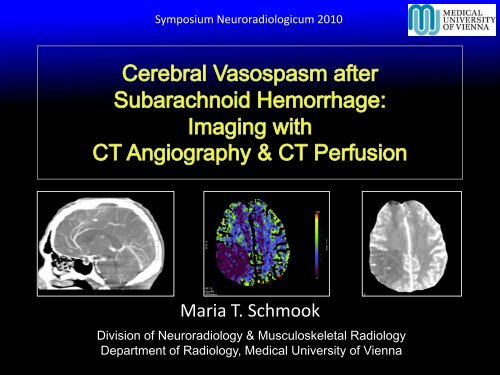Cerebral Vasospasm after Subarachnoid Hemorrhage: Imaging with ...
Cerebral Vasospasm after Subarachnoid Hemorrhage: Imaging with ...
Cerebral Vasospasm after Subarachnoid Hemorrhage: Imaging with ...
Create successful ePaper yourself
Turn your PDF publications into a flip-book with our unique Google optimized e-Paper software.
Symposium Neuroradiologicum 2010<br />
Maria T. Schmook<br />
Division of Neuroradiology & Musculoskeletal Radiology<br />
Department of Radiology, Medical University of Vienna
• Background information on vasospasm<br />
• CTA & CTP as diagnostic tools<br />
• Comparison of imaging modalities<br />
• Case presentation
• Frequent complication of aneurysmal SAH<br />
• High prevalence (70%)*<br />
• 1.5-3 fold increase in mortality<br />
• DCI is a serious complication of vasospasm<br />
– 50% develop ischemic neurologic deficits*<br />
DCI = delayed cerebral ischemia * Van Gijn et al 2001
<strong>Cerebral</strong> <strong>Vasospasm</strong> -Diagnosis<br />
• Best clinical indicator<br />
• new neurologic deficits<br />
• <strong>Imaging</strong> modalities<br />
• Transcranial Doppler sonography<br />
• Unhenhanced CCT<br />
• CTA & CT perfusion<br />
• MRI & MR perfusion<br />
• Gold standard DSA<br />
• Prompt treatment can<br />
improve neurologic outcome
<strong>Vasospasm</strong> in CT Angiography<br />
• Pros<br />
– Non-invasive<br />
– Rapid data<br />
acquision<br />
– minimal sedation<br />
sufficient if necessary<br />
– High specificity<br />
(95%)*<br />
– High NPV (94%)*<br />
• Cons<br />
– Low sensitivity (75.6%)<br />
– Coil artifacts interfere<br />
<strong>with</strong> vessel evaluation<br />
– Reduced accuracy for<br />
distal ICA # & distal<br />
branches<br />
– DD hypoplasia<br />
/vasospasm can be<br />
difficult<br />
* Wintermark et al 2006 # Bighani et al 2007
• 52a patient <strong>with</strong> AcoA aneurysm
• 52a patient <strong>with</strong> AcoA aneurysm
• 52a patient <strong>with</strong> AcoA aneurysm
• <strong>Vasospasm</strong> 3d <strong>after</strong> GDC embolisation
<strong>Vasospasm</strong> in CT Perfusion<br />
• Pros<br />
– Non-invasive<br />
– Rapid data<br />
acquision &<br />
processing<br />
– Equivalent results<br />
to MR perfusion<br />
– Widely available<br />
in emergency<br />
setting<br />
• Cons<br />
– Limited anatomical<br />
coverage<br />
– Motion artifacts<br />
interfere <strong>with</strong><br />
evaluation<br />
– Less suitable for<br />
posterior fossa<br />
strokes, small infarcts<br />
– Radiation dose
efore<br />
<strong>after</strong> GDC embolisation<br />
• 33a patient <strong>with</strong> aneurysmal SAH, day 0
• 33a patient <strong>with</strong> MCA Aneurysm & SAH
TTP<br />
CBF<br />
• 33a patient <strong>with</strong> aneurysmal SAH<br />
CBV
Day 0 Day 7<br />
Day 8<br />
Day 26<br />
• 33a patient <strong>with</strong> aneurysmal SAH
Day 8<br />
Day 4<br />
Day 3<br />
Day 0 Day 7<br />
Papaverine . i. a.<br />
Day 26<br />
• 33a patient <strong>with</strong> aneurysmal SAH<br />
Day 7<br />
TTP<br />
Papaverine i. a
Dx of <strong>Vasospasm</strong>: MTT (6.4s): highest accuracy, sensitivity & NPV<br />
Wintermark et al, AJNR 2006
• Diagnosis of vasospasm requiring endovascular therapy<br />
– Best predictor: cortical rCBF (≥39.3ml/100g/min)<br />
– Highest NPV: MTT (≤7.6s)<br />
• Combined CTA & PCT represents an accurate screening test<br />
– High specificity of CTA & high sensitivity of PCT<br />
– This approach may help to decrease the number of invasive DSA in<br />
selected lower-risk patients<br />
Wintermark et al, AJNR 2006
TTP MTT<br />
CBF CBV<br />
Wintermark et al 2006
Wintermark et al 2006
• As a diagnostic tool for DCI,<br />
qualitative assessment of CTP is<br />
overall superior to NCT and CTA<br />
•It could be useful for fast<br />
decision-making and guiding<br />
treatment<br />
Dankbaar et al, Stroke 2009
Dankbaar et al, Neuroradiology 2009<br />
• Significant CBF difference (21%) between flow<br />
territories of severe and no vasospasm<br />
• In 65%, flow territory of most spastic vessel<br />
corresponded <strong>with</strong> least perfused region<br />
• Delayed cerebral ischemia in 35% of patients<br />
• In 57/38%21% of pts <strong>with</strong> severe/moderate/<strong>with</strong>out<br />
vasospasm
Radiation dose!<br />
Loftus M et al , AJR 2010<br />
•Unenhanced CT 1.5-2.5mSv, CTA 2.5 mSv, CTP 1-6.7 mSv
Conclusion<br />
• Combined CTA & PCT represents an accurate<br />
and easy-to-use diagnostic test to assess<br />
vasospasm & brain perfusion<br />
• CTA & PCT may help in reducing the number<br />
of invasive DSA examinations in selected<br />
lower-risk patients<br />
THANK YOU!



